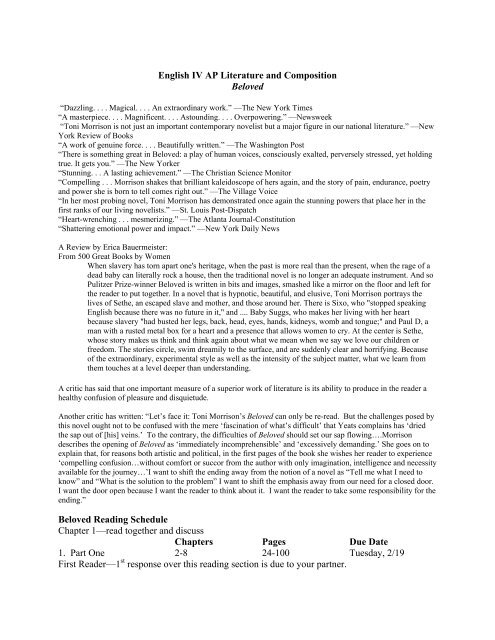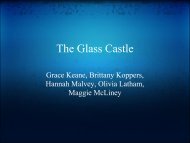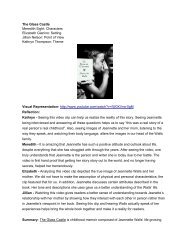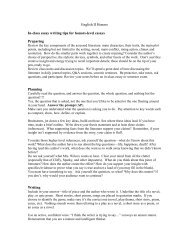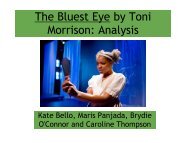English IV AP Literature and Composition Beloved Beloved Reading ...
English IV AP Literature and Composition Beloved Beloved Reading ...
English IV AP Literature and Composition Beloved Beloved Reading ...
Create successful ePaper yourself
Turn your PDF publications into a flip-book with our unique Google optimized e-Paper software.
<strong>English</strong> <strong>IV</strong> <strong>AP</strong> <strong>Literature</strong> <strong>and</strong> <strong>Composition</strong><br />
<strong>Beloved</strong><br />
“Dazzling. . . . Magical. . . . An extraordinary work.” —The New York Times<br />
“A masterpiece. . . . Magnificent. . . . Astounding. . . . Overpowering.” —Newsweek<br />
“Toni Morrison is not just an important contemporary novelist but a major figure in our national literature.” —New<br />
York Review of Books<br />
“A work of genuine force. . . . Beautifully written.” —The Washington Post<br />
“There is something great in <strong>Beloved</strong>: a play of human voices, consciously exalted, perversely stressed, yet holding<br />
true. It gets you.” —The New Yorker<br />
“Stunning. . . A lasting achievement.” —The Christian Science Monitor<br />
“Compelling . . . Morrison shakes that brilliant kaleidoscope of hers again, <strong>and</strong> the story of pain, endurance, poetry<br />
<strong>and</strong> power she is born to tell comes right out.” —The Village Voice<br />
“In her most probing novel, Toni Morrison has demonstrated once again the stunning powers that place her in the<br />
first ranks of our living novelists.” —St. Louis Post-Dispatch<br />
“Heart-wrenching . . . mesmerizing.” —The Atlanta Journal-Constitution<br />
“Shattering emotional power <strong>and</strong> impact.” —New York Daily News<br />
A Review by Erica Bauermeister:<br />
From 500 Great Books by Women<br />
When slavery has torn apart one's heritage, when the past is more real than the present, when the rage of a<br />
dead baby can literally rock a house, then the traditional novel is no longer an adequate instrument. And so<br />
Pulitzer Prize-winner <strong>Beloved</strong> is written in bits <strong>and</strong> images, smashed like a mirror on the floor <strong>and</strong> left for<br />
the reader to put together. In a novel that is hypnotic, beautiful, <strong>and</strong> elusive, Toni Morrison portrays the<br />
lives of Sethe, an escaped slave <strong>and</strong> mother, <strong>and</strong> those around her. There is Sixo, who "stopped speaking<br />
<strong>English</strong> because there was no future in it," <strong>and</strong> .... Baby Suggs, who makes her living with her heart<br />
because slavery "had busted her legs, back, head, eyes, h<strong>and</strong>s, kidneys, womb <strong>and</strong> tongue;" <strong>and</strong> Paul D, a<br />
man with a rusted metal box for a heart <strong>and</strong> a presence that allows women to cry. At the center is Sethe,<br />
whose story makes us think <strong>and</strong> think again about what we mean when we say we love our children or<br />
freedom. The stories circle, swim dreamily to the surface, <strong>and</strong> are suddenly clear <strong>and</strong> horrifying. Because<br />
of the extraordinary, experimental style as well as the intensity of the subject matter, what we learn from<br />
them touches at a level deeper than underst<strong>and</strong>ing.<br />
A critic has said that one important measure of a superior work of literature is its ability to produce in the reader a<br />
healthy confusion of pleasure <strong>and</strong> disquietude.<br />
Another critic has written: “Let’s face it: Toni Morrison’s <strong>Beloved</strong> can only be re-read. But the challenges posed by<br />
this novel ought not to be confused with the mere ‘fascination of what’s difficult’ that Yeats complains has ‘dried<br />
the sap out of [his] veins.’ To the contrary, the difficulties of <strong>Beloved</strong> should set our sap flowing….Morrison<br />
describes the opening of <strong>Beloved</strong> as ‘immediately incomprehensible’ <strong>and</strong> ‘excessively dem<strong>and</strong>ing.’ She goes on to<br />
explain that, for reasons both artistic <strong>and</strong> political, in the first pages of the book she wishes her reader to experience<br />
‘compelling confusion…without comfort or succor from the author with only imagination, intelligence <strong>and</strong> necessity<br />
available for the journey…’I want to shift the ending away from the notion of a novel as “Tell me what I need to<br />
know” <strong>and</strong> “What is the solution to the problem” I want to shift the emphasis away from our need for a closed door.<br />
I want the door open because I want the reader to think about it. I want the reader to take some responsibility for the<br />
ending.”<br />
<strong>Beloved</strong> <strong>Reading</strong> Schedule<br />
Chapter 1—read together <strong>and</strong> discuss<br />
Chapters Pages Due Date<br />
1. Part One 2-8 24-100 Tuesday, 2/19<br />
First Reader—1 st response over this reading section is due to your partner.
2. Part One 9-18 101-195 Friday, 2/22<br />
Second Reader—2 nd response over this reading section is due to your partner.<br />
3. Part Two 19-25 199-277 Thursday, 2/28<br />
First Reader—3 rd response over this section of the reading is due to your partner.<br />
4. Part Three 26-28 281-324 Tuesday, 3/4<br />
Second Reader—4 th response over the last section is due to your partner.<br />
Your <strong>Beloved</strong> writing assignment will an ongoing Google document that you <strong>and</strong> your partner<br />
create as you read <strong>Beloved</strong>. When you create your document, invite me (mwilcox4@gmail.com)<br />
along with your partner. Begin reading logs (two each) with someone assigned to you from your<br />
class—designated “first reader” <strong>and</strong> “second reader.” Focus on a specific <strong>and</strong> prominent motif<br />
you <strong>and</strong> your partner notice, tracking its development throughout the novel.<br />
The day your assigned reading log is due, you have some choices. You may print off a hard<br />
copy or you may show me a copy on your electronic device. Suggested length: no less than a full<br />
page, but do not go over two.<br />
At the conclusion of the book, in partnership, edit, clean-up, revise your reading responses,<br />
combine them in chronological order in some kind of bound, thematically decorated notebook or<br />
other organizer <strong>and</strong> turn in. Please designate in different fonts or colors whose thoughts belong<br />
to which responder.<br />
In your logs, consider the following:<br />
Characters—How do they change <strong>and</strong> interact with <strong>Beloved</strong>? Who is the protagonist? Who is the heroine?<br />
Consider the growth of the following characters:<br />
• Baby Suggs<br />
• Sethe<br />
• Halle<br />
• Paul D<br />
• Denver<br />
• <strong>Beloved</strong><br />
• Stamp Paid<br />
Symbols<br />
Biblical Allusions<br />
• tree on Sethe’s back, scars “I will call them my people…”<br />
• water/baptism Romans 9:25, 9:26, 1:22, 23<br />
• fetters/chains<br />
• colors Loaves <strong>and</strong> Fishes/Last Supper<br />
• milk of motherhood Matthew 15:15, Mark 6, Luke 9<br />
• ghosts<br />
• characters as symbols Horsemen Riding<br />
• birds, rooster Revelations 6:2, 7:17<br />
• ribbon in water<br />
• address 124<br />
• Trees<br />
• feet<br />
• pregnancy<br />
• metal, tin box, red heart<br />
• Amy D’s velvet<br />
• Butter/churn<br />
• Community or lack thereof (isolation from a community <strong>and</strong> devastating toll)
Language—Toni Morrison says of her writing, “My language has to have holes <strong>and</strong> spaces so the reader can<br />
come into it.”<br />
• Poetic<br />
• Beautiful<br />
• Paradoxical<br />
• Reveals/conceals at the same time<br />
• Repetition of the words <strong>and</strong> phrases—unspeakable thoughts unspoken<br />
• Stream of consciousness monologues<br />
• Intermingling of the voices within a chapter—especially the later<br />
• Repetition of words <strong>and</strong> phrases. For example the schoolteacher’s story is told 12 times. Only the last time<br />
is the story fully revealed.<br />
Irony<br />
“Sweet Home”<br />
Garner says of his slaves, “My n***** are men”—yet everything they do negates their “manhood.”<br />
Sethe becomes a slave to <strong>Beloved</strong>.<br />
Irony in the graphic descriptions.<br />
Baby Sugg’s freedom is bought at expense of her son’s bondage. Baby Suggs is amazed Halle can underst<strong>and</strong> the<br />
need to be free when he himself has never experience the joy.<br />
For years Paul D believed school-teacher broke into children what Garner had raised into men. Can you declare<br />
someone to be a man?<br />
Graphic descriptions—detailed accounts of the horrific/ understatement. When she wrote she tried to use the most<br />
quiet language to describe what was really the most horrific experiences (the epitome of understatement).<br />
Mystery—who is <strong>Beloved</strong>?<br />
“Sometimes I feel like a Motherless Child” Billie Holiday sang.<br />
Do you resent <strong>Beloved</strong>? What must have been like to be a motherless child?<br />
Who is <strong>Beloved</strong>? Who is she <strong>and</strong> what does she represent?<br />
• Sethe’s conscience<br />
• Catalyst for confronting the past<br />
• Horrors of slavery<br />
• Confronting the middle passage<br />
• Spirit of a disenfranchised people<br />
• A ghost<br />
• Catalyst for revelations/healing<br />
• Adult <strong>and</strong> child<br />
• The voice of the middle passage<br />
• A daughter looking for her mother<br />
• A freed slave<br />
Setting<br />
Sweet Home vs. 124<br />
Community—the clearing/ the river, etc.<br />
The effects of African Americans after the Civil War, Reconstruction, Fugitive Act of 1850.<br />
Structure & Progression of novel<br />
<strong>Beloved</strong> does not follow a linear plot line. It circles from past to present with series of flashbacks that gradually<br />
reveal the central characters’ stories. Keep track of the events as they unfold. When you are finished create a visual<br />
of the events, contrasting them to a st<strong>and</strong>ard chronological order.<br />
Points of View—the haunting story of a mother’s love that frames a series of interrelated love stories. Keep track of<br />
who is speaking <strong>and</strong> how this voice affects the message.<br />
Themes<br />
• Rememory—importance of past <strong>and</strong> its connection to the present <strong>and</strong> how it defines the future.<br />
• Community—healing power of women, sisterhood <strong>and</strong> ties that bind<br />
• Isolation of the individual<br />
• Slavery’s destructive effects on all aspects of life, especially motherhood <strong>and</strong> masculinity, humanity <strong>and</strong><br />
identity.<br />
• Freedom


